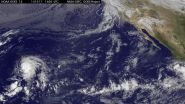INFORMATION:
The lead author of the paper is Sujith Puthiyaveetil, a post-doctoral research associate in the Institute of Biological Chemistry. The other authors are Onie Tsabari and Ziv Reich of Israel's Weizmann Institute of Science; Troy Lowry and Steven Lenhert of Florida State University; and Robert R. Lewis of WSU Tri-Cities.
WSU researchers see how plants optimize their repair
Structures play key role in healing sun's damage
2014-10-20
(Press-News.org) PULLMAN, Wash.—Researchers led by a Washington State University biologist have found the optimal mechanism by which plants heal the botanical equivalent of a bad sunburn. Their work, published in the Proceedings of the National Academy of Sciences, could lead to the development of crops that can repair the sun's damage more easily, improving yields and profitability.
Helmut Kirchhoff, an assistant professor in WSU's Institute of Biological Chemistry and corresponding author of the PNAS paper, said plants have had to deal with solar damage since the evolution of photosynthesis some 3.5 billion years ago. The process produces energy for the plant but also creates modified oxygen molecules, called reactive oxygen species, or ROS, that can damage proteins and other important plant molecules.
"ROS production can't be avoided, only minimized," said Kirchhoff. "It becomes a big problem for plants under unfavorable environmental conditions, like too much heat, too much light or insufficient nutrition."
Kirchhoff and his colleagues focused on a specialized system of photosynthetic membranes inside the chloroplast, which converts sunlight to energy. The membranes contain sophisticated molecular-scale nanomachines that are the prime target of oxidative damage. Other nanomachines can repair the damage.
Earlier researchers have found that the machines make repairs in multiple steps. Each step depends on the success of its predecessor, and Kirchhoff and his colleagues determined that the required order of steps is established by the separating of different repair proteins to different membrane regions. This compartmentalization is guaranteed by folding of the membrane.
"Until now, it was not known how the order of events is guaranteed," Kirchhoff said. "Our results suggest that we have to understand the structural characteristics and dynamics of photosynthetic membranes to understand the repair of the energy-converting nanomachines. This has not been appreciated before."
It's possible that this insight could help scientists generate plant mutations with membrane architectures that make more efficient repairs, said Kirchhoff. Plants might be tailored by geographic regions or climate zones.
"It could be good to improve the repair machinery in hot and bright climates," he said, "but it would be counterproductive for temperate climate zones."
ELSE PRESS RELEASES FROM THIS DATE:
See-through, one-atom-thick, carbon electrodes powerful tool to study brain disorders
2014-10-20
PHILADELPHIA — Researchers from the Perelman School of Medicine and School of Engineering at the University of Pennsylvania and The Children's Hospital of Philadelphia have used graphene -- a two-dimensional form of carbon only one atom thick -- to fabricate a new type of microelectrode that solves a major problem for investigators looking to understand the intricate circuitry of the brain.
Pinning down the details of how individual neural circuits operate in epilepsy and other neurological disorders requires real-time observation of their locations, firing patterns, ...
Gonzalo: First hand account in Bermuda, next stop: The United Kingdom
2014-10-20
Hurricane Gonzalo departed from Bermuda leaving power outages, downed trees, and damaged homes and buildings. An on-the ground account of the storm indicated the eye passed over the island. By Oct. 20, post-tropical storm Gonzalo was approaching the United Kindgom, sparking severe weather warnings.
By Sunday, Oct. 19 Gonzalo was affecting eastern Canada. Forecasters expect Gonzalo to hold together over while traveling east across the North Atlantic where it will affect Scotland as an extra-tropical storm on Tuesday, Oct. 21.
Camille Haley was former NASA intern and ...
The quick life and death of Tropical Storm Trudy
2014-10-20
Tropical Storm Trudy formed on Saturday, Oct. 17 and by Oct.19 the storm made landfall in southern Mexico and weakened to a remnant low pressure area.
Tropical Storm Trudy formed near the southwestern coast of Mexico during the morning of Oct. 18 triggering warnings and watches. A Hurricane Watch was posted from east of Acapulco to Laguna De Chacahua Mexico and a Tropical Storm Warning was posted for Tecpan De Galeana to Laguna De Chacahua Mexico.
On Sat. Oct. 18 at 8 a.m. EDT, radar from Mexico indicated that the center of Tropical Storm Trudy was located on the coast ...
NASA's Terra Satellite sees Tropical Storm Ana over Hawaii
2014-10-20
VIDEO:
This video shows the movement of Tropical Storm Ana near the Hawaiian Islands from Oct. 17-20.
Click here for more information.
Tropical Storm Ana made a slow track west of the Hawaiian islands over the last couple of days, and by Oct. 20 was moving westward away from the main Hawaiian islands and heading toward the northwest Hawaiian islands. NASA's Terra satellite caught Ana on a flyby on Oct. 19 that showed the storm's clouds blanketing the chain of islands.
The ...
Fires in the Egypt River Delta
2014-10-20
This NASA satellite image is of the Egyptian River Delta. Actively burning areas, detected by MODIS's thermal bands, are outlined in red. Each hot spot, which appears as a red mark, is an area where the thermal detectors on the MODIS instrument recognized temperatures higher than background. When accompanied by plumes of smoke, as in this image, such hot spots are diagnostic for fire. The location, widespread nature, and number of fires in this image and confirmation from the Ministry of Environment in Egypt. Fires are witnessed every year in October and November, caused ...
New study charts the fate of chemicals affecting health and the environment
2014-10-20
Looking forward in science often requires looking back, evaluating trends to extrapolate future outcomes. A classic case is Moore's Law, which predicts that the density of components on an integrated circuit will double every 24 months. The estimate has helped guide many developments in the computer industry.
In a new study, Rolf Halden, PhD, a researcher at Arizona State University's Biodesign Institute, examines the trajectory of chemicals appearing as emergent threats to human or environmental health.
Halden's meta-analysis of 143,000 peer-reviewed research papers ...
Siblings of children with autism can show signs at 18 months
2014-10-20
About 20% of younger siblings of children with Autism Spectrum Disorder (ASD) will develop the condition by age 3. A new study by Yale School of Medicine researchers has found that 57% of these younger siblings who later develop the condition already showed symptoms at age 18 months.
Published in the October Journal of the American Academy of Child & Adolescent Psychiatry, this is the first large-scale, multi-site study aimed at identifying specific social-communicative behaviors that distinguish infants with ASD from their typically and atypically developing high-risk ...
Obesity link to increased risk for orthopedic conditions and surgical complications
2014-10-20
ROSEMONT, Ill.—Obesity affects individual patient care, the healthcare system and nearly every organ in the body. People with obesity often have other health problems, including diabetes, heart disease, certain tumors and cancers, and psychiatric disorders. However, the role of obesity in orthopaedic conditions and their treatment is less well-publicized.
According to orthopaedic surgeon William M. Mihalko, MD, PhD, of Campbell Clinic Orthopaedics in Memphis, Tenn., "obesity can accompany a multitude of comorbidities that can have a significant impact on a patient's ...
Positive subliminal messages on aging improve physical functioning in elderly
2014-10-20
Older individuals who are subliminally exposed to positive stereotypes about aging showed improved physical functioning that can last for several weeks, a new study led by the Yale School of Public Health has found.
Researchers used a novel intervention method to examine for the first time whether exposure to positive age stereotypes could weaken negative age stereotypes and their effects over time, and lead to healthier outcomes.
The study, to be published online in an upcoming issue of the journal Psychological Science, consisted of 100 older individuals (average ...
Fish tale: New study evaluates antibiotic content in farm-raised fish
2014-10-20
Antibiotics—one of modernity's great success stories—are charms that come with a curse. Their overuse in human and animal populations can lead to the development of resistant microbial strains, posing a dire threat to global health.
In a new study, Hansa Done, PhD candidate, and Rolf Halden, PhD, researchers at Arizona State University's Biodesign Institute, examine antibiotic use in the rapidly expanding world of global aquaculture.
Done and Halden measured the presence of antibiotics in shrimp, salmon, catfish, trout, tilapia and swai, originating from ...
LAST 30 PRESS RELEASES:
Numbers in our sights affect how we perceive space
SIMJ announces global collaborative book project in commemoration of its 75th anniversary
Air pollution exposure and birth weight
Obstructive sleep apnea risk and mental health conditions among older adults
How talking slows eye movements behind the wheel
The Ceramic Society of Japan’s Oxoate Ceramics Research Association launches new international book project
Heart-brain connection: international study reveals the role of the vagus nerve in keeping the heart young
Researchers identify Rb1 as a predictive biomarker for a new therapeutic strategy in some breast cancers
Survey reveals ethical gaps slowing AI adoption in pediatric surgery
Stimulant ADHD medications work differently than thought
AI overestimates how smart people are, according to HSE economists
HSE researchers create genome-wide map of quadruplexes
Scientists boost cell "powerhouses" to burn more calories
Automatic label checking: The missing step in making reliable medical AI
Low daily alcohol intake linked to 50% heightened mouth cancer risk in India
American Meteorological Society announces Rick Spinrad as 2026 President-Elect
Biomass-based carbon capture spotlighted in newly released global climate webinar recording
Illuminating invisible nano pollutants: advanced bioimaging tracks the full journey of emerging nanoscale contaminants in living systems
How does age affect recovery from spinal cord injury?
Novel AI tool offers prognosis for patients with head and neck cancer
Fathers’ microplastic exposure tied to their children’s metabolic problems
Research validates laboratory model for studying high-grade serous ovarian cancer
SIR 2026 delivers transformative breakthroughs in minimally invasive medicine to improve patient care
Stem Cell Reports most downloaded papers of 2025 highlight the breadth and impact of stem cell research
Oxford-led study estimates NHS spends around 3% of its primary and secondary care budget on the health impacts of heat and cold in England
A researcher’s long quest leads to a smart composite breakthrough
Urban wild bees act as “microbial sensors” of city health.
New study finds where you live affects recovery after a hip fracture
Forecasting the impact of fully automated vehicle adoption on US road traffic injuries
Alcohol-related hospitalizations from 2016 to 2022
[Press-News.org] WSU researchers see how plants optimize their repairStructures play key role in healing sun's damage






